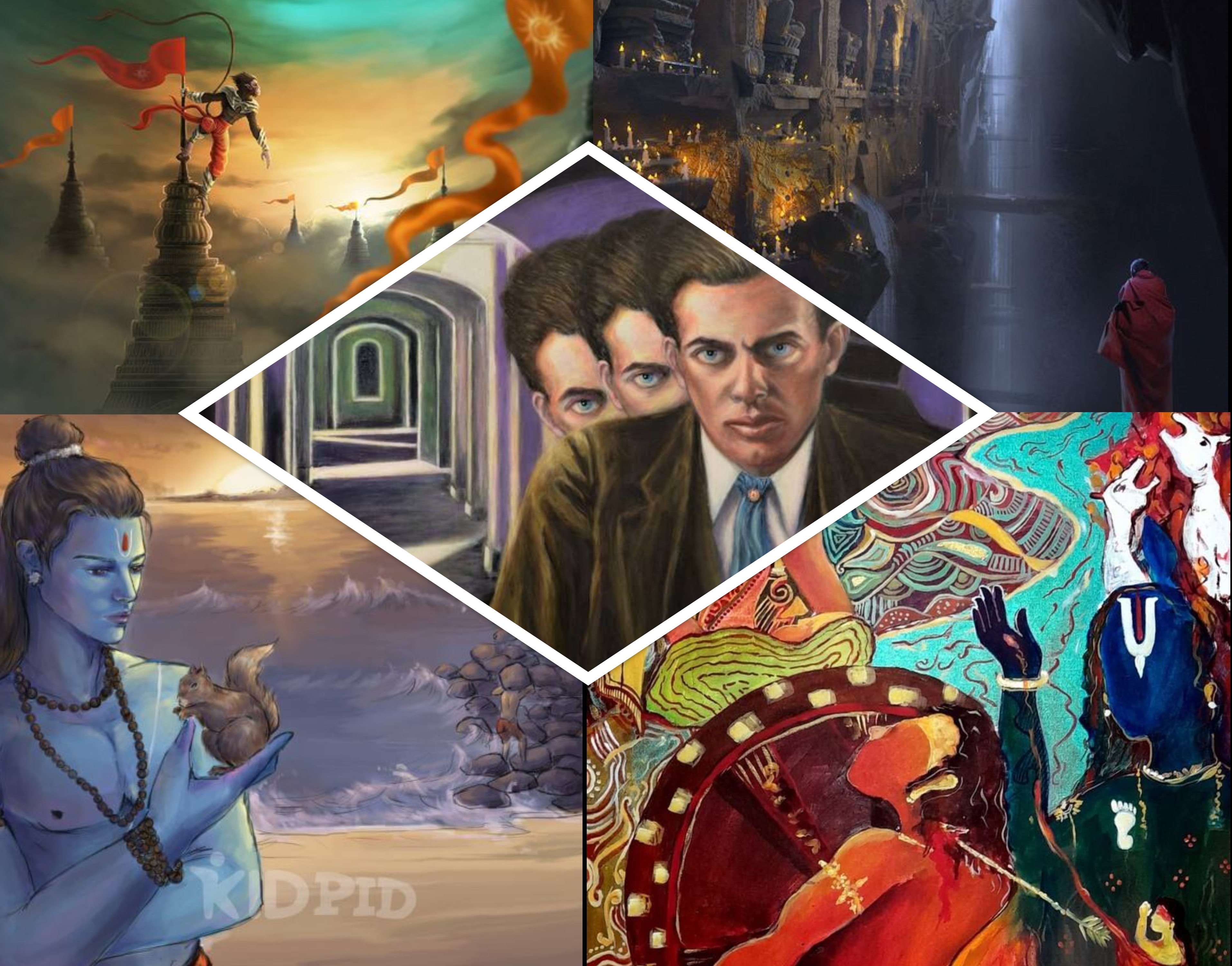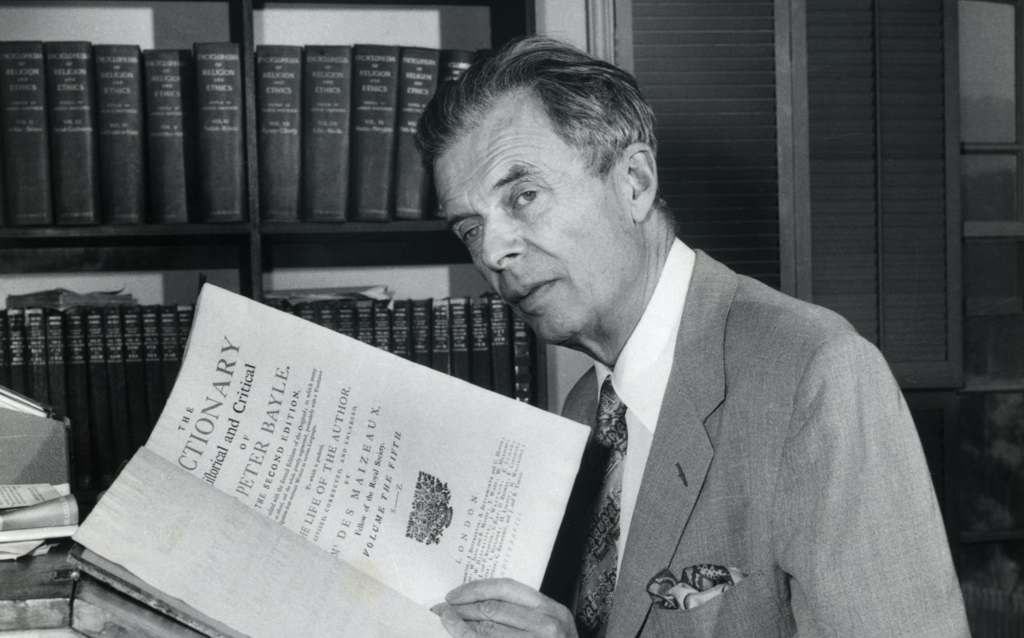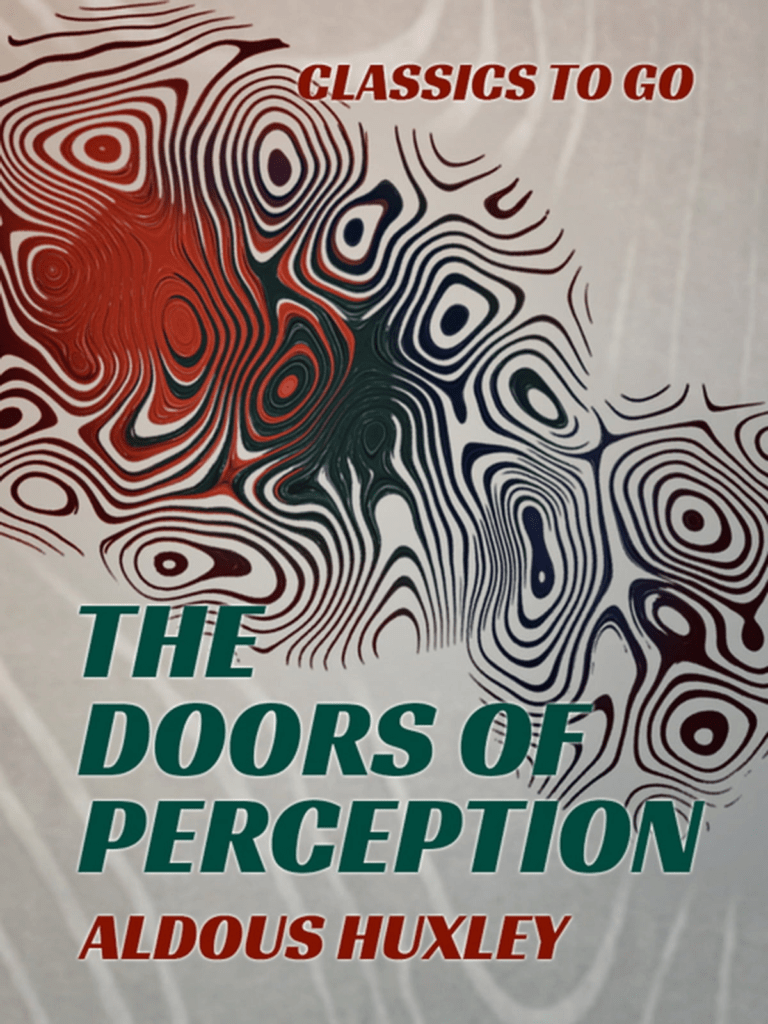- Visitor:53
- Published on:
Indian Influences in developing Aldous Huxley’s Thought: Part IV
Hinduism, he said tried to represent the superhuman and the metaphysical and, as a result, “Hindus have evolved a system of art full of metaphysical monsters and grotesques”. Carrying on the discussion, he concluded that the “Hindus are too much interested in metaphysics and ultimate reality to make good artists. Art is not the discovery of Reality – whatever reality may be… It is the organization of chaotic appearance into an orderly and human universe”.

….continued from the last part

Art
Hindu art has been incomprehensible to most Western critics, particularly of the colonial era and they often used harsh epithets like ‘barbarous’, ‘ugly’, etc., to describe it. But it was not so with Huxley. He found much in Indian art to appreciate even while he used Western standards of judgement. He could also see though obscurely that Indian art was in some radical way different and it was trying to express another feeling, another dimension. But at this stage, he had no proper comprehension of this dimension and also no intellectual sympathy with it. Therefore, after going about in India, it confirmed him even further in his European standards. He tells us with great selfsatisfaction that a visit to India “makes one realize how fortunate, so far at any rate as the arts are concerned, our Europe has been in its religions”. He said that while in its Pagan traditions, the Olympian deities were men made gods, in its Christian tradition, the Saviour was God made man. But in neither the artist was asked to go beyond the boundaries of real and actual human life. However, it was different in Hinduism, which though it permitted the representation of the human, thought that “the human is not enough”. Hinduism, he said tried to represent the superhuman and the metaphysical and, as a result, “Hindus have evolved a system of art full of metaphysical monsters and grotesques”. Carrying on the discussion, he concluded that the “Hindus are too much interested in metaphysics and ultimate reality to make good artists. Art is not the discovery of Reality – whatever reality may be… It is the organization of chaotic appearance into an orderly and human universe”. But all this was changed when he accepted the spiritual dimension. His definition of “Reality” changed; his understanding of what is “human” changed. He developed different standards and different criterions of judgement. He developed a new eye for Hindu-Buddhist art. He also began to look at European art, music, and literature from a new angle; for example, now he began to notice the absence of a “detached character” in Shakespeare. Similarly, he began to see that the higher transcendental dimension which he had now begun so much to value was either missing or was at least very inadequately expressed in European art tradition. This point becomes clear when we read, for example, his essays on ‘Variations on a Baroque Tomb’, or ‘Variations on El Greco’ contained in his Themes And Variations published in 1950. Discussing baroque art of the seventeenth century, he speaks of its failure to find an adequate artistic expression for the mystical experience, even when its artists were rendering saints in ecstasy who were often shown gesticulating and swooning under an epileptic fit; they were often represented not with God, but with their physiology in a state hardly distinguishable from that of sexual enjoyment. He points to Berini’s statues of Blessed Ludovica Albertoni and the more celebrated St. Teresa in ecstasy and his failure to deal with the subject.19 At the end, he concludes that “no fully adequate rendering of the contemplative life was ever achieved in the plastic arts of Christendom”.

According to Huxley one great symbol through which, in the past, the spiritual life has been most clearly and powerfully expressed is landscape painting. He observes that from time immemorial deity has been associated with the boundlessness of earth and sky, with the longevity of trees, rivers and mountains, and space and time on the cosmic scale have been symbols of the infinity and eternity of Spirit. He points out that the first artists to concern themselves with the spiritual significance of Nature were the Taoist landscape painters of China, and that when long after landscape painting was discovered in Europe, the artists had no philosophy to explain and justify what they were doing – that work was left to poets like Wordsworth, Shelley and Whitman. To show the contrast between the Western and the Far Eastern approach to nature, he quotes from the handbook on painting by Cennino Cennini whose recipe for mountains is: take some large jagged stones, arrange them on a table, draw them and, lo and behold, you will have a range of Alps or Apennines good enough for all the practical purposes of art. Huxley observes that in China and Japan mountains were taken more seriously. The aspiring artist was advised to go and live among them, to make himself alertly passive in their presence, to contemplate them lovingly until he could understand the mode of their being and feel within them the workings of the immanent and transcendent Tao. Huxley also says that another form in which man has expressed his deep spiritual vision is a human figure. In fact, a human figure in response is the best symbol of life in God or even of God himself. But this presupposes a very different understanding of man and divinity than the one found in Semitic religions. In this approach man in his innermost being is divine (not sinful as in Christianity), and Indian art has tried to express this being, this inner divinity as best as it could. This however presupposes a great science of contemplation and a developed art of inner exploration. In Indian art-tradition, when Gods are rendered into visual art-forms, they must first be contacted on subtle planes through meditation. The sculptor undergoes a strict regimen of fasting and meditation until he is ready to “receive” their transcendental-form or forms; the forms thus revealed in meditation (dhyâna-rûpâNi) are then translated into visible forms (vyakta-rûpâNi). Christianity has no idea of an inner-man, or of man’s inner depths; and therefore there is nothing to search or find there. As a result, in the Western art-tradition, the problem has been very much simpler and it hardly caused any complication. According to John P. Lundy, author of Mounumental Christianity, God the Creator is often represented by Jesus; in Venetian Mosaics, a young and beardless young man is breathing into man the breath of life, or handing to Adam a little spirit with butterfly wings; in illumined Bibles of the fifteenth century, he is shown with cruciform nimbus creating the world. In these representations he is often shows with a beard and about thirty years old. In the sixteenth century, he is often replaced by the figure of Pope. The Pope is shown in full canonicals creating Eve or appearing to Job seated in clouds and holding the globe in his hands and also embodying the Trinity. W.E.H. Lecky tells us that in Christian art, when the Father began to be painted, in “Italy, Spain, and the ultramontane monasteries of France, He was usually represented as a Pope; in Germany, as an Emperor; in England, and, for the most part, in France, as a King”. Christianity treated its other ‘pious’ subjects with no greater vision. The depiction of Jesus passed through many artistic styles and followed many fashions into which we need not to go here, but a few salient facts may be mentioned. In early representations, Jesus was sometimes rendered as a chubby and sunny youth in imitation of Greek Gods who had beautiful forms. But precisely for that very reason in order to oppose and spite them, Jesus was also painted ugly and deformed. Many important Christian theologians taught that Jesus was “the ugliest of the sons of men”; others taught that Jesus was a “man of sorrow”, a man who never laughed. Even so, however, inadequate in conception, some of these early depictions were devout and succeeded in expressing piety and solemnity of a sort. But, eventually, Christian art settled for expressing suffering, cruelty, horror and loathsomeness. It specialized in portraying the legends of martyrs, the agonies of the lost, the hot fires in which the heretics burned. Jesus himself was often shown as a tortured figure hanging on a cross with a crown of thorns pressing on his brow and the wounds on his side dripping blood. All this had little spirituality in it but it appealed to a perverse imagination and a morbid mind. According to Huxley, though peace that passes all understanding was often sung and spoken in the writings of such mystics as Eckhart, Tauler and Ruysbroeck, but it failed to find expression in Christian art. He notices that nowhere there are “equivalents of those Far Eastern Buddhas and Bodhisattvas who incarnate, in stone and print, the experience of ultimate reality”. Is this omission accidental or has it deeper causes? Huxley does not discuss this question directly, but, I think, his answer is clear. In one sense and on its own plane, Christian artistic performance was not unimpressive. Christian artists were talented and innovative; they performed all the tasks set for them by their religion and fulfilled all its needs for what they were worth. They portrayed a sky-god, thrones, clouds and winged angles; and with equal profusion they portrayed devils who had their own iconography; they portrayed the Virgin and the Apostles; they portrayed the Day of Judgement and the resurrection of the martyrs clamouring for revenge; they painted hell-fire with great conviction and fervour; they portrayed the blessed and the damned and the joys of the former at the sight of the agonies of the latter. That there is little spirituality in all this is another matter. Similarly, they discovered important techniques like perspective and foreshortening by which they could portray the third dimension, and render horizons and depths in space. But this did not help them to render the spiritual dimension, the spiritual horizons and depths of man’s being. That required a different kind of preparation and Christianity gave them no guidance in that direction. The fact is that Christian art failed at a deeper level. It failed not in execution but in conception and vision, and this failure was at bottom failure of Christian theology in which mysticism is rudimentary and peripheral. Christian theology has no concept of transcendence, nonattachment, recollectedness, equality (samatâ), liberation (moksha), the vast (bhûmâ) and the infinite (ananta), compassion (kuruNâ), of cosmic action emanating from restfulness at the centre; therefore, it felt no call to try to convey them in its art-forms. A deeper iconography needed the support of a deeper theology and vision. This explains why Christian art has no equivalents of Far Eastern Buddhas and Bodhisattvas as Huxley notices. The Eastern tradition was shaped by Hindu religious thinking and sensibility. Hindu art tried to portray the inner man: the Man behind the man, the Eye behind the eye, the Seeing behind the seeing, man’s inner prâNika or life-currents, the nodal points in his subtle body where the individual meets the cosmic. It portrayed man’s inner physiognomy. Christian theology knew nothing of this inner physiognomy, and it remained unportryed in its art. Christian artists were often great anatomists and they painted attractive figures of lovely curves with draperies tastefully arranged; they studied and understood the structure of human body and rendered it in various postures and motions with their muscles and sinews. But they portrayed the external man; there was no portrayal of the inner man, the luminous man, the transcendental man. The idea behind Hindu-Buddhist art was to convey inner realities through figures and symbols. The underlying idea of Christian art was to narrate Biblical stories or to propagate a creed or dogma through picture-forms. In this task, it succeeded very well. Very little can be said about Muslim art, at least in the sense in which we understand the word. Much of it is funerary art.

In India, Huxley saw many specimens of Muslim architecture and he thought that as a whole “Mohammedan art tends … to be dry, empty, barren, and monotonous”. Huxley also visited the Taj at Agra and he was much disappointed. He found the building expensive and picturesque but architecturally uninteresting. He thought that it was elegant but its elegance was of a “very dry and negative kind”, and its classicism came not from an “intellectual restraint imposed on an exuberant fancy”, but from “an actual deficiency of fancy, a poverty of imagination”. He compared it with contemporary European buildings in the neo-classical style of the High Renaissance, and he found it inferior in comparison. Comparing it with Hindu architecture, he said: “The Hindu architects produced buildings incomparably more rich and interesting as works of art. I have not visited Southern India, where, it is said, the finest specimen of Hindu architecture are to be found. But I have seen enough of the art in Rajputana to convince me of its enormous superiority to any work of the Mohammedans. The temples at Chitor, for example, are specimens of true classicism”. According to him, its fabulous “costliness is what most people seem to like about the Taj”, and that because it is made of marble. But “marble”, he say, “covers a multitude of sins”. Its costliness makes up for its lack of architectural merit. It could be said that art is not Islam’s forte as it repudiates it and, therefore, it has not developed it. But there is a another and even more important side of the question. The fact is that Islam also did not need much in the way of art. It had little to convey or communicate in the way of deeper spiritual truths. Its God was best satisfied with demolition of the shrines of “other Gods”, and it was in that direction that Islam found its best self-expression, both religious and artistic. In this, it was not alone. It shared this passion of demolition with other iconoclastic religions including Christianity – we forget what it did in its heyday. But the facts cannot be kept under the carpet for all time. The question is opening up again and the iconoclastic ideologies are under interrogation.

Chemical Doors
For more than a decade, Huxley had been preaching a mystical view, the presence of another world beyond the veil of the mind. But his empirical mind still sought verification of the world of which his deeper intellect was already assured. This came in 1953 when he took mescalin. It brought to him some wonderful visionary experiences. Later, he experimented with LSD and Marijuana (about ten times in all). In the experiences induced by them, a deeper dimension was added. He saw the “togetherness” of all things and their essential “alrightness”. He described his visionary experiences in his The Doors of Perception, and discussed the problem of visions in a larger theoretical framework in his Heaven And Hell. Unfortunately, these books provided intellectual support to the psychedelic drug movement that enveloped America and Europe in the sixties. Drugs could not have done much harm to Huxley, for he was already internally prepared; but the story was different with thousands of young men who came under the sway of the drug movement. Huxley had always some use for drugs in influencing the mind. In his Brave New World, citizens use Soma to suppress any suggestions of a higher reality and ideal; in his Island, Moksha-medicine is used to provide occasional glimpses into higher reality, “an hour or two, every now and then, of enlightening and liberating grace”. The rest depends on you whether you choose to “cooperate with the grace”, or continue to behave like “silly delinquents”. Habitual meditation is one of the ways in which one cooperates with those gratuitous graces. It helps in cultivating a state of mind where dazzling ecstatic insights become a permanent and assured possession. It helps man to know himself to the point that one is not “compelled by one’s unconscious to do all the ugly, absurd, self-stultifying things that one so often finds oneself doing”. That Huxley held to this view till the end becomes obvious from his posthumous work, Moksha, edited by M. Horowitz and C. Palmer, where the story is told through his letters, extracts from his previous works, his addresses to learned societies, and his articles in journals, both scientific and popular. In many cultures, some people do resort to drugs for heightened and out-of-the-way experiences, but higher Indian spirituality disfavours it. It prescribes only the method of yama, niyama, Sîla, tapas, samâdhi and prajñâ for higher aims of liberation. Godly life is holy ground; there should be no gate-crashing here, no short-circuiting. The path has it own lessons and beauties and the destination itself is in the path.
East and West
European soldiers, traders, missionaries – later on ably assisted by its colonial ideologies and scholars – opened up the East to the influences of the West. But Huxley belonged to that small group of European thinkers and seekers who opened up the West to the influence of the East – a more arduous task and in the long run perhaps more important too. He did not seek this role, it was merely a bye-product of his search for truth. Huxley was one of the finest products of Europe – of a new Europe seeking its old roots, of a Europe no longer satisfied with mere technology and science and rationality but seeking a new dimension of the spirit, a Europe self-critical and in search. He was also a profound student of Europe’s various traditions, religious, literary and artistic, and he discusses them with great knowledge, insights, authority and intimacy. In his hands, cultural Europe becomes alive. A critical discussion of Europe by such a sympathetic insider is meant to help, to fecundate; it can do no harm but will only help Europe in its spiritual rediscovery. In opening up to India and China, it would merely be opening up to an ancient tradition which was lost by her but preserved and developed in India and China.
Mahabharata and Ramayana
Though Huxley came late but his name stands high on the list of those who have opened up the West to the philosophies of the East. He however spoke to a highly intellectualized audience. Perhaps it was necessary at that stage; Europe had to be approached through its intellect. But now a different channel of communication is needed. The message too has to have a more vital clothing. I believe that the Ramayana and the Mahabharata fill the bill. They represent embodied spirituality and reveal the higher dimension when it becomes dynamic in life; they give us “life-creations” of the Vedânta philosophy on which Huxley wrote so much (sixteen articles for Vedanta for the Western World and ten for Vedanta for Modern Man). We all, whether in the East or the West, need their message. Not only do they offer the highest yogas, and the highest spiritual wisdom, they also offer the great social ideals, which we need badly today. At present, our social relations – filial, parental, fraternal, conjugal, civic – are tending to become empty. They revolve round a mere utilitarian nexus and have lost the higher dimension and therefore, they bring no fulfilment. The Ramayana and the Mahabharata can help in restoring this lost dimension.

Bibliography:
Swarup, Ram, 2000. Chapter 5 Development in Huxley’s Thought: Hindu-Buddhist Influences, On Hinduism Reviews and Reflections.
Center for Indic Studies is now on Telegram. For regular updates on Indic Varta, Indic Talks and Indic Courses at CIS, please subscribe to our telegram channel !
- 26 min read
- 0
- 0










